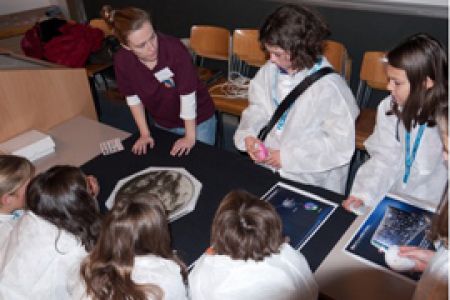
On Saturday, 12th November, a group of 240 young girls aged 11-14, sporting white lab coats, took the Science building of the University of Geneva by storm. From early in the morning until the afternoon they experienced, among other things, programing a robot, building a solar-powered car and even getting a taste of what is going on at CERN and particle physics.
The activities were part of the Expanding Your Horizons (EYH) programme, created in 1974 by a group of women working in science and education, focused on encouraging young women to engage in science, technology, engineering and mathematics.
The first of the EYH workshops in Europe was held in Geneva two years ago (more than 90 conferences of this kind were running yearly in the USA and Asia by that time).
CERN, having already participated in 2009, had a career booth this year and covered 3 of the 11 workshops, organised by universities and companies (like Google, SIG, EPFL or Novartis): “Seeing the invisible”, in which the girls could build a cloud chamber; “Any cooler and you freeze!” where they had fun with liquid nitrogen; and “Questions without answers” in which the main unsolved topics of particle physics where presented and in which CMS participated.
In the three sessions of “Questions without answers”, groups of 15-25 girls were received with an introduction to the field given by Claudia Wulz. They were then taken around through four exhibits discussing the most exciting questions that the LHC aims to answer: the mystery of the dark matter, presented by Maria Cepeda; the matter-antimatter imbalance; the origin of the masses of the particles; and the nature of the early Universe.
After that, they were presented with items relating to the experimental setup used to answer these questions: they could build the ATLAS detector in the pop-up book, touch and inspect parts of ALICE and CMS detectors, and observe the cosmic rays in the room with a big spark chamber provided by the department of physics of the University of Geneva along with a portable counterpart provided by CMS.
The main attraction of the session was the “Salad bowl accelerator” presented by Barbara Millan Mejias, playing with which the girls could understand the principles of particle acceleration and participate in the process in several ways. They provided power with a Wimhurst machine, and transformed polystyrene balls into “accelerable” particles by giving them a coat of graphite. The girls experimented with different combinations of power, sizes and number of particles.
It was a very exciting session that we all enjoyed greatly. The girls left the workshop after having learnt a bit more about the field, and maybe we will see each other again in a few years, this time, working together!
— Submitted by Rebeca Gonzalez Suarez
- Log in to post comments

